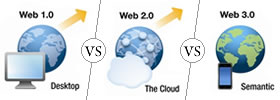The major differences among Web 1.0, 2.0 and 3.0
Web 1.0
It is the “readable” phrase of the World Wide Web with flat data. In Web 1.0, there is only limited interaction between sites and web users. Web 1.0 is simply an information portal where users passively receive information without being given the opportunity to post reviews, comments, and feedback.
Web 2.0
It is the “writable” phrase of the World Wide Web with interactive data. Unlike Web 1.0, Web 2.0 facilitates interaction between web users and sites, so it allows users to interact more freely with each other. Web 2.0 encourages participation, collaboration, and information sharing. Examples of Web 2.0 applications are Youtube, Wiki, Flickr, Facebook, and so on.
Web 3.0
It is the “executable” phrase of Word Wide Web with dynamic applications, interactive services, and “machine-to-machine” interaction. Web 3.0 is a semantic web which refers to the future. In Web 3.0, computers can interpret information like humans and intelligently generate and distribute useful content tailored to the needs of users. One example of Web 3.0 is Tivo, a digital video recorder. Its recording program can search the web and read what it finds to you based on your preferences
Web 1.0 - it's "just a link" between users, Web 2.0 - «social" communication and Web 3.0 - a "mobile" communication.
Web 1.0 professionals involved in the creation, and the content of the site, while Web 2.0 - primarily only in the establishment, in the era of Web 3.0, and both will be able to make anyone - without the knowledge of HTML, and even has special talents in design.






Комментариев нет:
Отправить комментарий